In this article:
Gynecomastia is a benign condition that affects males of all ages, in which the breast tissues become swollen or overdeveloped, often rooted in a hormonal imbalance between the male and female sex hormones.
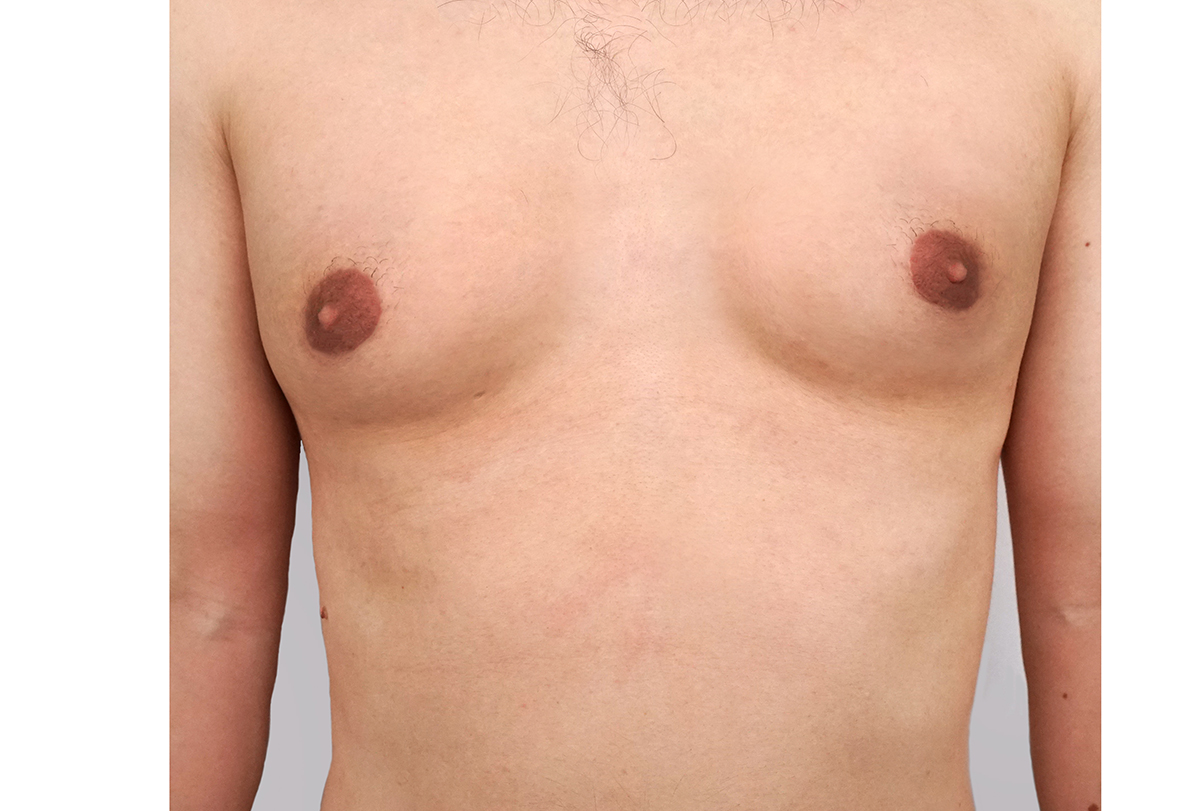
The fuller look of breasts in men can be embarrassing, emotionally disconcerting, and socially debilitating for the afflicted individual as it takes a huge toll on their confidence. It is a common problem, nevertheless, and occurs in 35% of men, being most prevalent in men between the ages of 50 and 69. (1)
While breast glands are a part of the male anatomy, they are typically small and underdeveloped and therefore not noticeable. Gynecomastia can lead to the enlargement of one or both breasts due to the proliferation of male breast glandular tissue. (2)
Another similar condition by the name of lipomastia is often confused for gynecomastia. Unlike gynecomastia, however, lipomastia or Pseudogynecomastia stems from the presence of fat deposits in the breast area of obese men rather than glandular proliferation.
Natural Ways to Address Gynecomastia
Here are some non-medical and non-invasive interventions that may help reduce enlarged breasts in men:
1. Perform chest muscle targeting exercises
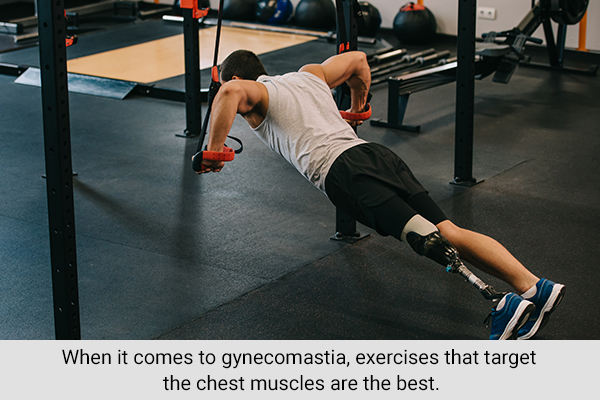
When it comes to gynecomastia, exercises that target the chest muscles are the best. One such exercise that you must do is the barbell bench press.
To do this exercise:
- First, set the barbell on the rack. You need to be ready to take the medium grip on the bar.
- Lift the bar in one smooth move and hold it straight over your body.
- While inhaling, lower the bar midchest.
- Exhale as you return back to your starting position.
- Do 10–15 reps for 3 sets on a daily basis.
Pec-deck machine and bent-forward cable crossovers are two other exercises that work out the chest muscle effectively and can be a good addition to your exercise routine.
2. Engage in exercises or physical activity
In mild cases of gynecomastia, a good diet and exercise may be sufficient to undo the damage. (3)
By reducing overall body fat, these lifestyle choices also play a fundamental role in the treatment of Pseudogynecomastia, which is responsible for the feminization of the male breast due to fat buildup.
You must try to include high-intensity interval training to help reduce gynecomastia as it helps correct the hormonal imbalance. This is corroborated by a 2017 study published in Endocrine Connects, which suggests that high-intensity interval training increases total testosterone in sedentary older males. (4)
Apart from high-intensity interval training, also try to:
- Include cardiovascular, weightlifting, and elliptical exercises in your exercise routine.
- Swimming, especially the breaststroke, is effective in reducing excessive chest fat.
- Jogging and walking are good forms of exercise that also help burn a lot of calories and body fat.
3. Incorporate fish oil in your diet
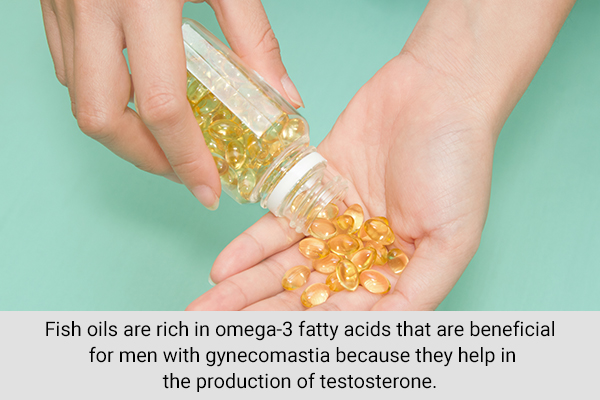
Fish oils are rich in omega-3 fatty acids that are beneficial for men with gynecomastia because they help in the production of testosterone.
These fatty acids offer the added advantage of simultaneously reducing estrogen levels, thereby restoring the optimum balance between male and female hormones and mitigating the growth of male breasts.
An animal study published in the International Journal of Fertility and Sterility in 2016 suggests that long-term fish oil supplementation influences semen quality and testosterone concentrations. (5)
How to consume:
- Take fish oil supplements. You can also take omega-3 supplements. Consult your doctor for the correct dosage and usage.
- Alternatively, eat cold-water fish such as salmon, tuna, and mackerel, which are rich in omega-3 fatty acids.
4. Apply a cold compress
Gynecomastia often causes the breasts to become tender and even painful at times. Applying cold compress to alleviate the pain and tenderness is a time-tested strategy of considerable merit.
The cold temperature causes the breast tissues to contract. This, in turn, has a numbing effect on the affected area and works to reduce swelling and pain. (6)
How to use:
- Wrap a few ice cubes in a thin towel.
- Put this cold compress on each of the breasts for 1 minute only.
- Do this treatment as needed.
Note: Do not apply ice directly on the skin as it can cause further irritation and damage to the skin and can even result in a frostbite.
5. Try using passionflower
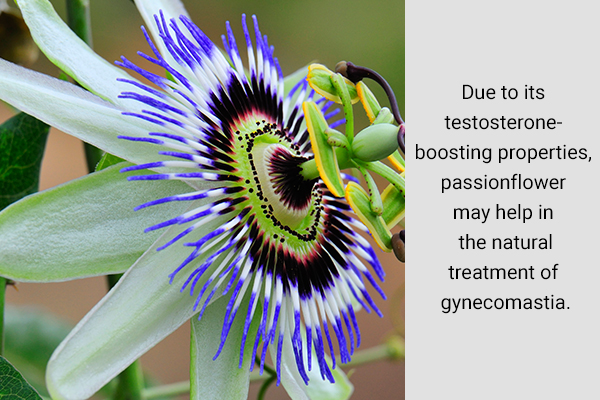
Due to its testosterone-boosting properties, passionflower may help in the natural treatment of gynecomastia. It contains a compound called chrysin that keeps the body from breaking down testosterone.
A study published in Open Access Text proposes the use of passionflower extract as an effective treatment to increase testosterone levels and redress gynecomastia, particularly in older men. However, further investigation is needed to conclusively establish the efficacy of this remedy. (7)
Furthermore, this herb has also been proven helpful in assisting with withdrawal from alcohol and certain drugs.
How to use:
- Steep 1 teaspoon of dried passionflower in 1 cup of water for 10 minutes. Strain and drink this herbal tea a few times a day.
- Alternatively, you can take this herb in supplement form. For proper dosage, consult your doctor.
6. Increase your zinc intake
Consuming zinc-based foods also help in the treatment of gynecomastia, especially when it is caused by low testosterone levels. This is because zinc has been found to increase testosterone naturally.
Conversely, several studies have attributed decreased levels of testosterone to a deficiency of zinc. (8) Because low testosterone is one of the leading causes of gynecomastia, zinc is considered particularly useful against this condition.
How to consume:
- Eat foods that are high in zinc, such as oysters, fortified breakfast cereal, lobster, cashews, yogurt, raisins, and chickpeas.
- You can also take zinc supplements after consulting your doctor.
7. Consume flaxseeds
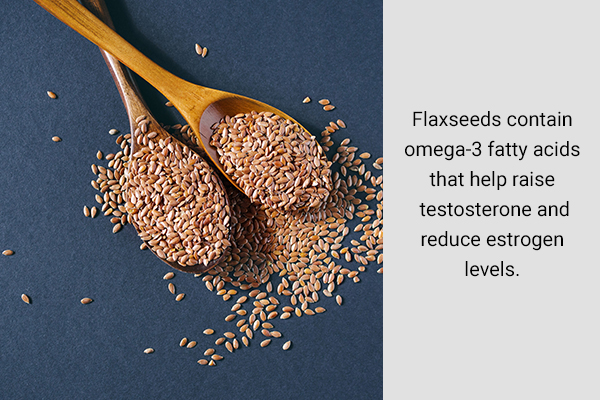
Flaxseeds also contain omega-3 fatty acids that help raise testosterone and reduce estrogen levels. Plus, they contain higher concentrations of lignans that balance estrogen activity and have antiestrogenic qualities.
According to Oregon State University, flaxseeds contain some of the highest levels of lignans. (9)
Flaxseeds also aid in the removal of harmful toxins from the body.
How to consume:
- Add 1 tablespoon of ground flaxseed to 1 glass of hot water and consume it daily until you see improvement.
- Another option is to take 1 or 2 tablespoons of flaxseed oil daily for a few weeks.
- You can also add ground flaxseed to smoothies and baked goods, such as bread and muffins.
Note: Consult your doctor before taking flaxseed as a remedy as it may interfere with certain medications and hormone treatments.
Additional Remedy
Turmeric
Turmeric is a well-known home remedy for gynecomastia. This spice can increase testosterone hormone levels in males. (10)
When the level of testosterone becomes high, large breasts in men naturally reduce in size. Plus, turmeric promotes liver health and helps burn fat, both of which can further contribute to mitigating male breast enlargement.
A 2017 study published in the Journal of Biomedical Science found that ingestion of the conventional dose of curcumin and nanocurcumin resulted in a significant elevation of the testosterone level in people with testicular atrophy induced by a protein-deficient diet (PDD). (10)
How to use:
- Add 1 or 2 teaspoons of turmeric to a cup of water and heat it for 10 minutes. Drink it 2 or 3 times a day, especially before going to bed. Repeat daily, and within a few weeks, you will notice the changes.
- You can also take turmeric capsules under the guidance of a doctor.
Note: Consult your doctor before taking turmeric as a remedy as it can further aggravate stomach problems like gastroesophageal reflux disease (GERD) in some people. Plus, it may worsen gallbladder problems and interfere with blood-thinning medications as well.
Causes of Gynecomastia
Although men produce both male and female hormones, gynecomastia usually develops because of alterations in the ratio of free androgen to estrogen. (11)
The condition sets in due to irregularities in the male hormonal environment either during infancy or puberty, characterized by a relative excess of estrogen activity and decreased testosterone activity.
Estrogen is the hormone that is responsible for female traits like breast growth, whereas testosterone is responsible for male physical features as well as sex drive and mood. Optimum testosterone levels are required for arresting the development of male breasts by counteracting the effect of estrogen on tissue growth.
Some of the main causes for gynecomastia (enlarged breasts in men) are:
- Puberty
- Age
- Hypogonadism
- Low testosterone (male hormone) levels
- Hyperthyroidism
- Chemotherapy
- Radiation treatment
- Chronic liver disease
- Exposure to pollutants
- Kidney failure
- Use of marijuana
- Excess alcohol consumption
- Malnutrition
The mother’s milk often imparts high levels of estrogen to infants, resulting in palpable breast tissue in many newborns that usually clears within a few weeks.
Side effects of certain medications can also cause this problem. Such medications include:
- Anti-androgen medications
- Anabolic steroids
- AIDS medications
- Anti-anxiety medications
- Antibiotics
- Ulcer medications
- Heart medications
- Gastric motility medications
- Blood pressure medications such as spironolactone
- Medications for cirrhosis
- Herbal medications like tea tree oil, lavender products, and Dong quai or female ginseng
Being overweight can also add to the problem.
Signs and Symptoms of Gynecomastia
Gynecomastia can affect one or both breasts and may also have an uneven development. The most common signs and symptoms include:
- Swollen breast glandular tissue
- Breast tenderness
Preventing Gynecomastia
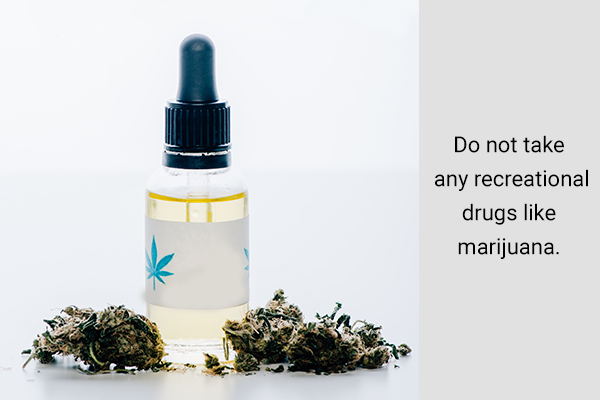
- Do not take any recreational drugs like marijuana.
- Do not take any illegal drugs for bodybuilding.
- Avoid excessive consumption of alcohol as it can worsen the condition.
- Do not smoke or use any other tobacco products.
- Avoid exposure to pollutants like lead as it can increase the risk of developing feminine breasts.
- Eat organic foods and use organic products to avoid exposure to toxic chemicals and hormones.
- Do not use tea tree oil or lavender oil or any other products made of these oils because they are considered as endocrine disruptors and tend to mimic the action of estrogen.
- Drink an ample amount of water throughout the day to help the cells function properly.
- Try to maintain a healthy body weight.
When to See a Doctor
The condition may require prompt medical attention if it is accompanied by:
- Pain
- Tenderness
- Swelling
- Discharge from one or both the nipples
There are some tell-tale signs that distinguish a case of gynecomastia from breast cancer. The latter is often characterized by:
- Enlargement in one breast mostly
- Swelling is not centered around the nipple
- The affected area is firm or hard to touch
- Enlargement of the breast or underarm lymph nodes
- Dimpled breast skin and retraction of the nipple
- Discharge from the nipple
ALSO READ: 14 Best Men’s Health Blogs and Websites
Final Word
Although not a serious problem, many men find it really tough to cope with gynecomastia and go to the lengths of having it medically or even surgically treated. There are, however, many simple home remedies that may work as a suitable adjunct treatment for gynecomastia.
Also, it is important to bear in mind that the problem may regress over time and resolve on its own.
- Was this article helpful?
- YES, THANKS!NOT REALLY


